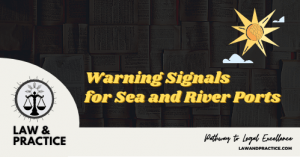Signals
|
Meanings
|
Distant Cautionary Signal No. I
|
There is a region of squally weather (wind speed of 61 kms/hour) in the distant sea where a storm may form.
|
Distant Warning Signal No. II
|
A storm (wind speed of 62-88 kms/hour) has formed in the distant deep sea. Ships may fall into danger if they leave harbour,
|
Local Cautionary Signal No.III
|
The port is threatened by squally weather (wind speed of 40-50 kms/hour).
|
Local Warning Signal No.IV
|
The port is threatened by a storm (wind speed of 51-61 kms/hour) but it doesn’t appear that the danger is as yet sufficiently great to justify extreme precautionary measures.
|
Danger Signal No. V
|
The port will experience severe weather from a storm of slight or moderate intensity (wind speed of 62-88 kms/hour) that is expected to cross the coast to the south of Chittagong port or Cox’s Bazar port and to the east of Mongla port.
|
Danger Signal No. VI
|
The port will experience severe weather from a storm of slight or moderate intensity (wind speed of 62-88 kms/hour) that is expected to cross the coast to the north of the port of Chittagong or Cox’s Bazar and to the west of the port of Mongla.
|
Danger Signal No. VII
|
The port will experience severe weather from a storm of light or moderate intensity (wind speed of 62-88 kms/hour) that is expected to cross over or near the port
|
Great Danger Signal No. VIII
|
The port will experience severe weather from a storm of great intensity (wind speed of 89 kms/hour or more) that is expected to cross the coast to the south of the port of Chittagong or Cox’s Bazar and to the east of the port of Mongal.
|
Great Danger Signal No. IX
|
The port will experience severe weather from a storm of great intensity (wind speed of 89 kms/hour or more) that is expected to cross the coast to the north of the port of Chittagong or Cox’s Bazar and to the west of the port of Mongla.
|
Great Danger Signal No. X
|
The port will experience severe weather from a storm of great intensity (wind speed of 89 kms/hour or more) that is expected to cross over or near the port.
|
Failure of Communication No. XI
|
Communications with the Storm Warning Centre have broken down and local officers consider that a devastating cyclone is following.
|





